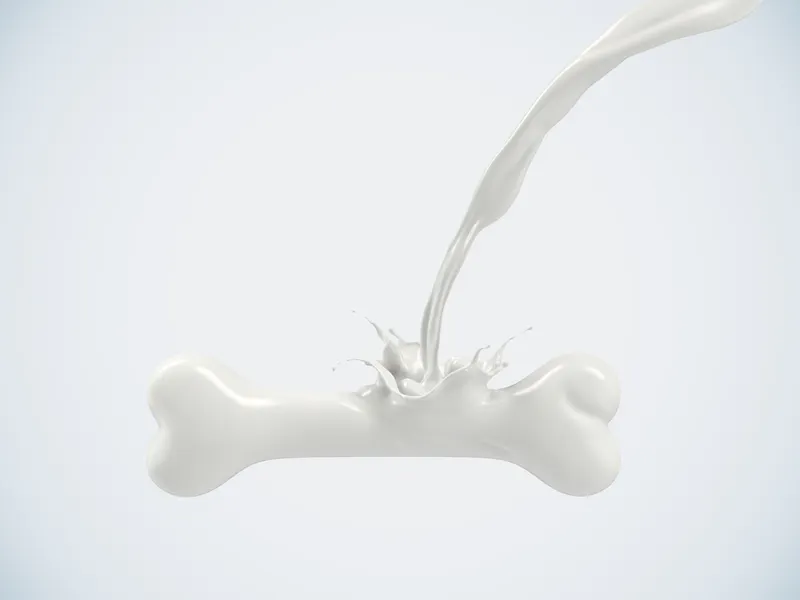What is osteoporosis?
What's covered?



Osteoporosis is a condition that weakens your bones, making them fragile and more likely to break or fracture. It affects more women than men and develops over many years. Typically, you only get diagnosed if you crack or break a bone. The good news is you can help prevent this condition and treat it with bone-strengthening medicines.
How do bones grow?
Your bones grow to their final length around age 16 to 18. But they’re constantly renewing themselves.
Your bone density (strength) peaks around your mid-20s. After this, new bone grows at the same rate as older bone breaks down. After age 40, bones break down faster than they grow, leading to bone loss and weaker bones.
What’s the difference between type 1 and 2 osteoporosis?
There are two types of osteoporosis. These include:
- type one osteoporosis — also known as post-menopausal osteoporosis. This results from lower oestrogen levels when you reach menopause
- type two osteoporosis — occurs in men and women aged 70+. This happens due to reduced bone growth and resorption. It’s also linked to spine, long bones, and hip fractures
What are the symptoms of osteoporosis?
Osteoporosis has no symptoms. So you might only know you have it once you break a bone.
The condition develops slowly over a few years, so it might only be detected if you have a bone density scan (DEXA scan). Your doctor might recommend a DEXA scan if:
- you’ve broken a bone after a minor fall or injury
- you have arthritis — this can lead to low bone density
There are no symptoms of osteoporosis, but there are some signs to look out for, including:
- loss of height over time
- stooped or bent-over posture
- a bone that breaks more easily than expected
- back pain caused by fractured or collapsed spinal bones (vertebra)
If you have osteoporosis, even a cough or sneeze can cause bones in your rib cage to break.
What causes osteoporosis?
Certain hormonal conditions can cause osteoporosis, including:
- hyperparathyroidism — where your parathyroid glands (found in your neck, near the thyroid gland) produces too much parathyroid hormone
- overactive thyroid (hyperthyroidism)
- low levels of oestrogen and testosterone
Certain health conditions can increase your risk of osteoporosis, including:
- Crohn's disease
- coeliac disease
- pituitary gland disorders
- an eating disorder — like bulimia or anorexia nervosa
- vitamin D deficiency — you can help prevent this by taking vitamin D supplements
Lifestyle factors can put you at risk too. These include:
- a body mass index (BMI) of 19 or less
- heavy drinking and smoking
- long-term inactivity — for example, if you’re bedridden due to illness
- taking high-dose steroids for more than three months — commonly used to treat rheumatoid arthritis and asthma
Some medicines used to treat breast and prostate cancer can also increase your risk of osteoporosis.
Learn how smoking and vaping impacts your health.
What causes osteoporosis in women?
Women are more likely to develop osteoporosis due to hormonal changes during menopause.
Before menopause, oestrogen helps to keep your bones healthy. But once you reach menopause, your oestrogen levels reach a new low level, affecting your bone health.
Because of these lower oestrogen levels, menopause is linked to a greater risk of fracturing your spine, hips, and wrists.
You’re at a greater risk of developing osteoporosis if you have:
- early menopause — your periods stop before age 45
- your womb removed (hysterectomy) before age 45 — particularly if you also have your ovaries removed (oophorectomy)
- absent periods for more than six months — resulting from over-exercising or excessive dieting
You can learn about your risk of osteoporosis by using a menopause insights blood test.
What causes osteoporosis in men?
The cause of osteoporosis in men is largely age-related bone loss. But there is a link to testosterone, which helps support bone health.
Most men continue to produce testosterone into old age, but there are some conditions where testosterone levels become low — like hypogonadism. Steroid tablets (glucocorticoids) can also affect bone strength in men.
Bone strength can also be affected by alcohol misuse. For example, consuming two or more alcoholic drinks a day poses a greater risk of developing osteoporosis. The exact mechanism is unknown, but it leads to reduced bone formation. Heavy alcohol use can also lead to being malnourished. This leads to your body absorbing less calcium and vitamin D. Both nutrients are crucial for bone health.
Learn more about how alcohol affects your health.
How to treat osteoporosis
Medicine
If you’re diagnosed with osteoporosis, your doctor will usually prescribe a medicine that helps to strengthen your bones and prevent fractures.
Bisphosphonates are the most common medications used to slow the bone breakdown rate. For women, they can also include selective oestrogen receptor modulators.
How to help prevent osteoporosis and falls
Get enough vitamin D
Vitamin D is essential for helping your body absorb calcium. Low vitamin D levels are associated with a higher risk of bone fractures.
In the UK, Public Health England advises all adults to take a daily vitamin D supplement between October and March. You can take a vitamin D supplement all year round if you don't have much sunlight exposure or have darker skin. Always check with your doctor before starting a supplement.
Get enough calcium
Calcium is an essential mineral for maintaining healthy bones.
Both men and women between the ages of 19 to 50+ need 700 mg of calcium daily.
If you’ve been diagnosed with osteoporosis, you might need more calcium. You can usually get enough calcium through your diet, but your doctor might recommend a supplement if you follow a plant-based diet.
Optimising calcium intake from food can help reduce your risk of developing osteoporosis.
Good food sources of calcium include:
- leafy green vegetables — like broccoli, kale, and spring greens
- animal milk — from cows (including lactose-free), goats, and sheep
- plant-based milk — like soya, oat, nut, coconut, pea, and rice
- cheese — like cheddar, edam, halloumi, and cottage cheeses
- plain yoghurt
- fortified bread and cereals
Follow a healthy lifestyle
The good news is, there are many things you can do to prevent osteoporosis. This includes:
- getting enough exercise — strengthens your muscles and reduces your risk of osteoporosis and falls
- aim for a mix of aerobic activities — like weight-bearing exercises and resistance training
Always speak to your doctor before increasing exercise time and intensity, especially if you have an existing condition. They can help you do this safely.
Other lifestyle changes include:
- stopping smoking
- reducing how much alcohol you drink — aim for no more than 14 units a week, and try to spread it out evenly throughout the week
Living with osteoporosis
If you're diagnosed with osteoporosis, you can reduce your chances of falling by removing hazards from your home and having regular eye and hearing tests.
To help you recover from a fracture, you can try using:
- painkillers like ibuprofen — to help reduce inflammation
- hot and cold treatments — like warm baths and cold packs
- relaxation techniques — like deep breathing and meditation
Speak to a healthcare professional if you're worried about living with osteoporosis. They can answer any questions or concerns you have.
Talking to a trained counsellor, psychologist, or others with this condition is also helpful.
You can also contact support groups — like the Royal Osteoporosis Society.
Al-Bashaireh, A. M., Haddad, L. G., Weaver, M., Chengguo, X., Kelly, D. L., & Yoon, S. (2018). The Effect of Tobacco Smoking on Bone Mass: An Overview of Pathophysiologic Mechanisms. Journal of osteoporosis, 2018, 1206235. https://doi.org/10.1155/2018/1206235
Benedetti, M. G., Furlini, G., Zati, A., & Letizia Mauro, G. (2018). The Effectiveness of Physical Exercise on Bone Density in Osteoporotic Patients. BioMed research international, 2018, 4840531. https://doi.org/10.1155/2018/4840531.
British Dietetic Association. Calcium: Food Fact Sheet. Retrieved 14 March 2023 from https://www.bda.uk.com/resource/calcium.html.
Cheraghi, Z., Doosti-Irani, A., Almasi-Hashiani, A., Baigi, V., Mansournia, N., Etminan, M., & Mansournia, M. A. (2019). The effect of alcohol on osteoporosis: A systematic review and meta-analysis. Drug and alcohol dependence, 197, 197–202. https://doi.org/10.1016/j.drugalcdep.2019.01.025
Choi, H. G., Jung, Y. J., & Lee, S. W. (2019). Increased risk of osteoporosis with hysterectomy: A longitudinal follow-up study using a national sample cohort. American Journal of Obstetrics and Gynecology, 220(6), 573-e1.
Jang, H. D., Hong, J. Y., Han, K., Lee, J. C., Shin, B. J., Choi, S. W., ... & Bang, C. (2017). Relationship between bone mineral density and alcohol intake: A nationwide health survey analysis of postmenopausal women. PLoS One, 12(6), e0180132.
National Health Services (2022). Osteoporosis. Retrieved 14 March 2023 from https://www.nhs.uk/conditions/osteoporosis/.
Osteoporosis Foundation (2022). Epidemiology, Burden, and Treatment of Osteoporosis in the United Kingdom. Retrieved 14 March 2023 from https://www.osteoporosis.foundation/sites/iofbonehealth/files/scope-2021/UK%20report.pdf.
Tang, B. M., Eslick, G. D., Nowson, C., Smith, C., & Bensoussan, A. (2007). Use of calcium or calcium in combination with vitamin D supplementation to prevent fractures and bone loss in people aged 50 years and older: a meta-analysis. Lancet (London, England), 370(9588), 657–666. https://doi.org/10.1016/S0140-6736(07)61342-7
Willers, C., Norton, N., Harvey, N. C., Jacobson, T., Johansson, H., Lorentzon, M., ... & SCOPE review panel of the IOF. (2022). Osteoporosis in Europe: a compendium of country-specific reports. Archives of osteoporosis, 17(1), 23.